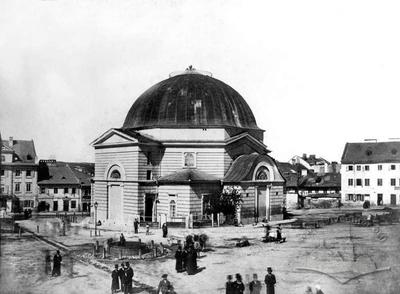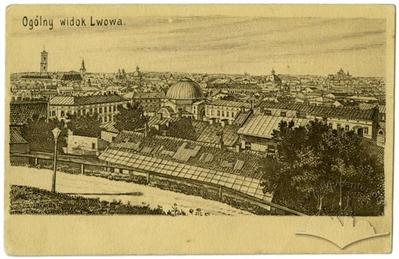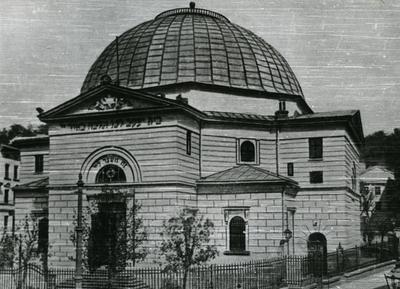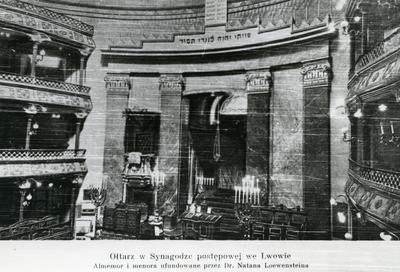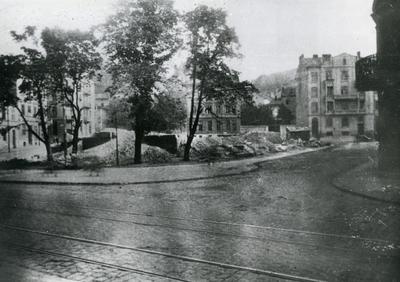Pl. Staryi Rynok – former Tempel synagogue ID: 566
The Lviv progressive synagogue, called Tempel (temple), was the first reformed synagogue in Galicia. It was a monumental building in Neoclassicist style, notable for its large dome; unlike European progressive synagogues with their typical oriental and Moorish decorative motifs (Berlin, Vienna or Budapest), it more resembled a Byzantine church. The Lviv Tempel was destroyed by the Nazis in the summer of 1941.
Story
1846 – the synagogue is
opened.
1896 – a project of the
synagogue reconstruction is designed by Julian Zachariewicz.
1906-1907 – the Tempel is
reconstructed under projects designed by Alfred Kamienobrodzki (rabbis’ and
cantors’ rooms at the eastern wall) and by Maurycy Silberstein (northern and
southern extensions with staircases).
1919 – the Tempel is restored under the direction
of Leopold Reis after the 1918 pogrom.
1941, summer – the Tempel is destroyed by the Nazis.
The Lviv progressive synagogue, Tempel (temple), was the first synagogue of the reformed type which appeared in Galicia as an echo of the Haskalah educational movement initiated in the late 18th c. in Berlin and widespread in Eastern Europe among Jewish intellectuals in the 19th c. The supporters of the Haskalah, the Maskilim, carried out a religious reform, bringing Jewish liturgy nearer to Christian divine service: now they had a cantor and a preacher and sometimes used the organ. In Galicia, the reformed Judaism spread in the 19th c. due to the initiative of Josef Perl, an educator, as well as due to the activities of Schlomo Jehuda Rappaport, an outstanding Galicianscholar, and Nachman Krochmal, a philosopher and writer.
The idea of the construction of a synagogue belonging to a new type was implemented by the Lviv Maskilim. In 1840, on the initiative of Emmanuel Blumenfeld, a lawyer, Nachman Krochmal, Solomon Rappaport, and Jakób Mieses formed a committee for the construction of a synagogue with the reformed rite, like the Temple in the German city of Kassel. Ivan Levytskyi (Jan Lewicki), a Lviv architect of Ukrainian origin, was commissioned to design the project.
The Lviv Tempel was constructed on the Staryi Rynok (Old Market) square, the fact causing mixed response of the Polish community. In particular, these views were expressed by architect Jan Sas-Zubrzycki:
"Polish Lviv under the Austrian rule allowed to construct a synagogue on the Old Market square, so that it completely overshadows the small church of St. John the Baptist ... Piotrowski, a conservative, rightly recalls that in the whole of Poland there was a requirement that no synagogue could exceed the Catholic church in significance and grandeur. Meanwhile, Lviv allowed that the new synagogue, built in 1845 on the pattern of the Protestant church, had a presbytery and even an apse... " (Sas-Zubrzycki, 1928).
In 1846 the synagogue was opened. It was a monumental Neoclassicist building, rather aggressively crammed into the existing urban structure and notable for its large dome. The Lviv progressive synagogue’s architecture was not similar to other European Temples, characterized by oriental and Moorish elements (e.g., in Berlin, Vienna or Budapest).
Half a century later, in 1896, the progressive community commissioned Julian Zachariewicz, a well-known architect and a professor of the Lviv Polytechnic, to draft a project of the progressive synagogue reconstruction. The architect suggested that the building should be filled with many elements of Jewish symbols. Zachariewicz grounded his restoration proposals on the Temple of Solomon in Jerusalem, interpreting Jewish symbols on the basis of the prophet Ezekiel’s texts. In particular, he suggested that two pillars should be installed at the entrance like pillars in Solomon’s Temple, the right one, called Jachin, or "God will establish", and the left one, called Boaz, or "Strength in Him". The project designed by Zachariewicz was never implemented.
In 1906-1907 the Tempel was reconstructed under projects designed by Alfred Kamienobrodzki (rabbis’ and cantors’ rooms at the eastern wall) and by Maurycy Silberstein (northern and southern extensions with staircases).
Among other Jewish buildings, the Lviv Tempel was damaged during the Polish pogrom in November of 1918. After the building was damaged by fire, it was repaired under the direction of Leopold Reis in 1919.
The first Tempel minister was Abraham Kohn (1844-1848), a rabbi from Western Austria. After him the following progressive rabbis served there: Schwabacher, B. Lowenstein, Josef Caro, a historian of the Jews of Lviv, S. Gutman, Lewi Freund, J. Lewin. From 1860 the synagogue was used both for religious gatherings and important public meetings of the progressive Jews. In addition to a German-language sermon (a Polish-language one from 1903), choir singing and organ music were introduced in the synagogue. In 1930 a progressive synagogue rabbi was elected Dawid Kahane, whose life was saved by the Metropolitan Sheptytskyi during the Holocaust.
In 1905 the supporters of the Haskalah planned to build another progressive synagogue in the city center (now Lystopadovoho Chynu street 8) on the initiative of Emil Byk. A project was designed whose author, August Bogochwalski, proposed an original structure, using historical styles in the décor. However, the death of the initiator in 1906 slowed down the implementation of this idea. Only after the war, in 1922, a conference was held with the aim of building another Tempel in Lviv. Yet because of disagreement in the community the idea was dismissed. The new progressive synagogue remained only on paper.
The Lviv Tempel was destroyed by the Nazis in the hot summer of 1941. Yevhen Nakonechnyi, a Lviv resident, describes it in detail in his memoirs:
"The Germans first set fire to it [the synagogue] to burn the temple decoration and then laid the dynamite and blew up the building. The sappers did their job well as no bricks flew over the area ... large chunks of the synagogue walls just collapsed on the spot, sinking down smoothly".
Architecture
Due to its centric composition design the Lviv Tempel resembled a Byzantine church. The octagonal block’s rusticated walls were topped with a huge spherical dome. The spatial structure was built on the basis of the two-tier octahedron, whose four faces were adjoined by rectangular wings according to the cardinal points. The west, north and south wings were accentuated by triangular frontons; the east, altar one, where the Torah niche was located, was lower and was underlined by a curved fronton. The four other faces were adjoined by single-tier triangular compartments turning the octahedron into a square. In the interior, the circular prayer hall was covered with a large dome. The walls were encircled by three tiers of galleries with ornamented parapets. The Aron haKodesh, merged with the bimah as an altar room in the east wing, was emphasized by four pilasters and closed by a curtain. In general, the progressive synagogue’s interior gave the impression of a theater hall. It was decorated by a beautiful altar and by an organ.
Related buildings and spaces
People
Józef Perl – an educator
Schloma Jehuda Rappaport – an outstanding Galician scholar
Nachman Krochmal – a philosopher, writer and maskil from Lviv
Solomon Rappaport – a Lviv maskil
Jakób Mises – a Lviv maskil
Emmanuel Blumenfeld – a lawyer
Ivan Levytskyi – a Lviv architect
Jan Sas-Zubrzycki – a Lviv architect
Julian Zachariewicz – a Lviv architect, Lviv Polytechic school professor who designed the Tempel reconstruction
Alfred Kamenobrodski – a Lviv architect
Maurycy Silberstein – a Lviv architect
Leopold Reiss – a Lviv architect, who overlooked the repairment works at the synagogue
Abraham Kohn – the first Tempel's administrator, a rabbi from Western Austria
Schwabacher – the progressive synagogue's rabbi
B. Lowenstein – the progressive synagogue's rabbi
Józef Caro – the progressive synagogue's rabbi, a historian of Lviv Jewish community
S. Gutman – the progressive synagogue's rabbi
Lewi Freund – the progressive synagogue's rabbi
J. Lewin – the progressive synagogue's rabbi
Dawid Kahane – the progressive synagogue's rabbi
Andrey Sheptytskyi – Ukrainian Greek Catholic Church Metropolitain
Emil Byk – a maskil who initiated the construction of a second Tempel in Lviv
August Bogochwalski – architect who designed a project of a second Tempel in Lviv which was never constructed
Yevhen Nakonechnyi – author of the book of memoirs "Шоа у Львові" (Shoah in Lviv)
Organizations
Sources
- Central State Historic Archives of Ukraine in Lviv (CDIAL), 701/3/1505.
- CDIAL, 19/12/2
- CDIAL, 19/12/5
- State Archive of Lviv Oblast (DALO), 2/2/3698.
- Бойко О., Синагоги Львова, (Львів, 2008)
- Бойко О. "Будівництво синагог в Україні", Вісник ін-ту Укрзахідпроектреставрація, ч. 9, (Львів, 1998), 5-33.
- Наконечний Є., "Шоа" у Львові, (Львів, 2004), 162-163.
- Давид Кахане, Щоденник львівського гетто, (Київ, 2003), 11.
- Bałaban M., Historia lwowskiej synagogi postępowej (Lwów, 1937)
- Janusz B., Przewodnik po Lwowie, (Lwów, 1922)
- Schall J., Przewodnik po zabytkach żydowskich Lwowa, (Lwów, 1935), 30-32.
- Zacharjewicz J., "Kilka słów o niedoszłej restauracyi Synagogi na placu Rybim we Lwowie", Czasopismo Techniczne, (Lwów, 1896), 60, 73-76.
- Zubrycki Sas J. Zabytki miasta Lwowa, (Lwów, 1928)
Citation
Oksana Boyko. "Pl. Staryi Rynok – former Tempel synagogue". Transl. by Andriy Masliukh. Lviv Interactive (Center for Urban History 2009). URL: https://lia.lvivcenter.org/en/objects/tempel-synagogue/Urban Media Archive Materials
